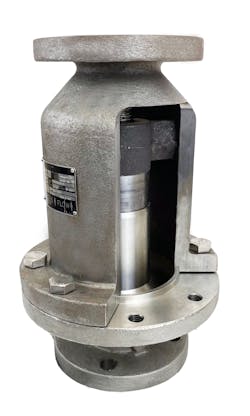Compact, High Flow Safety Relief Valve Design
For centuries, safety relief valves have served as a vital line of protection against excessive overpressure that left unaddressed can cause considerable damage to industrial processes including equipment failure and process upset, along with secondary hazards arising from an uncontrolled release of pressurized fluid.
These essential safety devices are designed to automatically open when the force exerted by the pressure reaches a setpoint to rapidly discharge the fluids. Once the overpressurization has dissipated, the valve recloses, conserving the remaining fluid.
In developing codes and standards, the industry has largely standardized around the 90-degree flow path design outlined by the American Petroleum Institute (API).
This standardized approach requires a drop in pressure inside the valve before it discharges fluid from the exit nozzle. To ensure proper performance, the orifice diameter at the inlet side is smaller than the nominal valve size, with an outlet diameter that is larger than both.
A 2 by 3-inch traditional API configuration safety relief valve will be designed with either a 0.785-inch diameter H orifice or a 1.287-inch diameter J orifice at its inlet and a 3-inch outlet, for example.
While it may be convenient for the purposes of standardization, other approaches to safety relief valve design are possible while meeting industry codes and standards such as those published by The American Society Of Mechanical Engineers (ASME), says Geof Brazier, Managing Director, BS&B Safety Systems, Custom Engineered Products Division.
“The traditional 90-degree standardized configuration has the unintended consequence of limiting the amount of flow that is possible,” adds Brazier.
So, BS&B had an idea: what if the safety relief valve was an inline device, with outlet and inlet connections that were the same size and an inlet orifice diameter to match the inlet connection?
“With an inline design, the flow moves in a straight line and doesn’t have to change direction,” says Brazier.
“The design allows for a certain amount of flow expansion, but we don’t have nearly the same level of turbulence inside the valve, which increases the capacity of the device,” says Brazier.
By having the inlet diameter match the nominal size of the valve, there is more flow [capacity]. The valve can also be more compact, lighter in weight, and requires smaller size and therefore less expensive piping. The result is simplified installation and a lower total cost of investment.
To address the need for increased flow, BS&B has introduced the IDV Safety Valve, a self-reclosing safety pressure relief valve that functions the same as a traditional safety relief valve but with an inline configuration rather than the traditional angle body configuration.
The inline configuration allows for up to three times the capacity of a conventional valve. The smaller the nominal size, the greater the capacity benefit from the IDV Safety Valve.
This technology enables customers to achieve the same overall outcome as a traditional valve. The increased capacity allows engineers and operators to optimize their pressure safety systems and, in many applications, reduce the piping configuration (line size) by one or more nominal sizes.
The IDV Safety Valve is compact and lightweight and can be installed using ANSI/ASME B 16.5 and international flange connections. Mounting can be either horizontal or vertical, adding to the flexibility of application for this design.
The set pressure levels are independent of backpressure, meaning the valve is suitable for variable backpressure applications.
The valve can be combined with an optional integrated rupture disk at the inlet and/or outlet. The combination of a rupture disk device with a safety relief valve has many benefits arising from valve isolation to the normal process conditions including optimal leak tightness, increased operating pressure, extended valve life, and reduced valve maintenance.
The IDV has already been installed in over 10,000 processes worldwide, making it an established alternative to the safety relief valve that meets the same codes and standards.
For more information, contact BS&B Safety Systems at 7455 East 46th Street, Tulsa, OK 74145-6379, call: (918) 622-5950, e-mail: [email protected] or visit www.bsbsafety.co.




